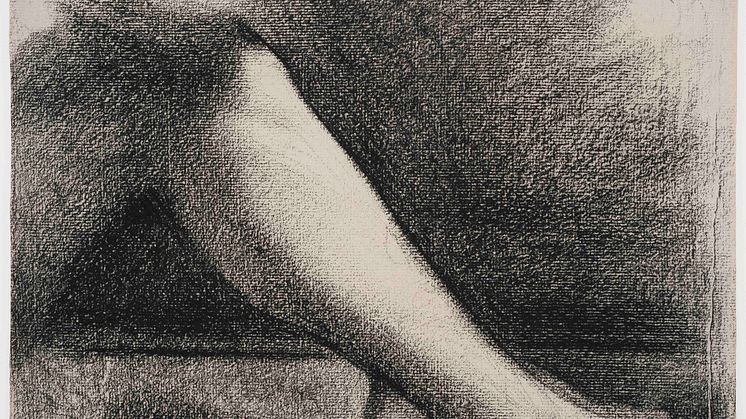
Press release -
New acquisition: Crayon study by Georges Seurat
Through a bequest in the will of the late Mrs Peggy Bonnier, Georges Seurat’s study of a pair of legs for the painting Bathers at Asnières (1884) has been donated to Nationalmuseum. The work exemplifies Seurat’s technique of drawing on heavily grained paper with Conté crayons. Although the piece is a preliminary study for one of the artist’s best-known paintings, it also has qualities that make it valuable in its own right.
Alongside the Louvre, Nationalmuseum possesses one of the world’s most significant collections of older French drawings, thanks largely to the art collector Carl Gustaf Tessin. During his travels and his time as Swedish ambassador in Paris in the mid-18th century, Tessin took every opportunity he could to acquire contemporary and older French masterpieces on paper. When he sold his collection in 1750 to Crown Prince Adolf Fredrik of Sweden, it was almost complete.
After the collection passed into royal and later public ownership, for many years a lack of knowledge, funding and interest made it impossible to continue acquiring new works and rounding out the collection. However, in the mid-20th century, a more active and targeted purchasing policy was adopted with a view to filling some of the gaps, especially with respect to the late 18th and early 19th centuries.
A typically black drawing by Georges Seurat (1859–1891), the French neo-impressionist master, has long ranked high on Nationalmuseum’s wish list. The magnificent bequest by the late Mrs Elisabeth “Peggy” Bonnier (1922–2013) is therefore a dream come true. The Seurat drawing was purchased by the donor’s late husband Gerard Bonnier, a prominent art collector and publisher, as a gift to his wife on her 50th birthday.
The new acquisition, depicting a pair of bent legs, is a detail study for one of the figures in Seurat’s famous painting Bathers at Asnières (1884), now in the National Gallery in London. The drawing exemplifies Seurat’s technique of drawing on heavily grained paper with Conté crayons, which consisted of a compressed mixture of powdered graphite or charcoal with a wax or clay base. All the lines are subordinated to the entire surface and to expanses in varying shades of black, produced using different amounts of pressure on the crayon. At the same time, the drawing is a closed composition in its own right, with the leg forming a light, diagonal band across the image.
Further information
Ulf Cederlöf, senior curator
collections, ulf.cederlof@nationalmuseum.se, +46 8 5195 4402
Hanna Tottmar, press
officer, hanna.tottmar@nationalmuseum.se, +46 767 23 46 32
Caption
George Seurat, Crayon study of a pair of legs, 1884. Photo:
Anna Danielsson/Nationalmuseum.
Categories
Nationalmuseum is Sweden’s premier museum of art and design. The collections comprise older paintings, sculpture, drawings and graphic art, and applied art and design up to the present day. The museum building is currently under renovation and scheduled to open again in 2017. In the meantime, the museum will continue its activities through collaborations, touring exhibitions and a temporary venue at the Royal Swedish Academy of Fine Arts, Fredsgatan 12, Stockholm. Nationalmuseum collaborates with Svenska Dagbladet, Fältman & Malmén and Grand Hôtel Stockholm. For more information visit www.nationalmuseum.se.

